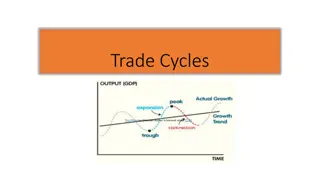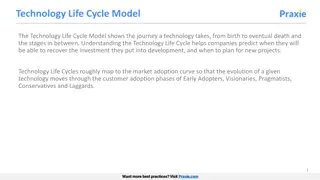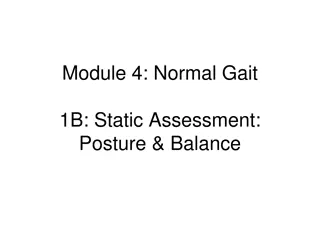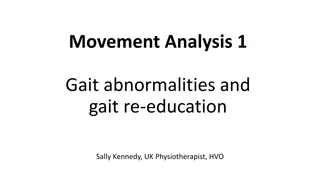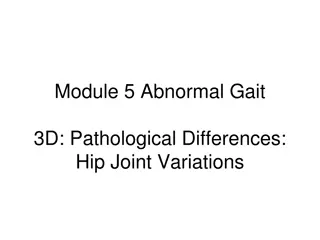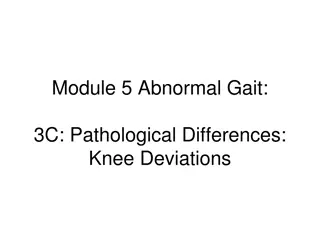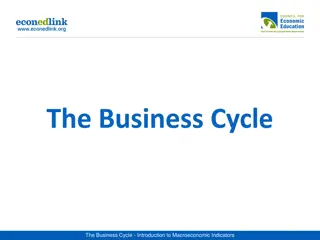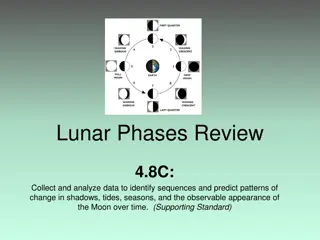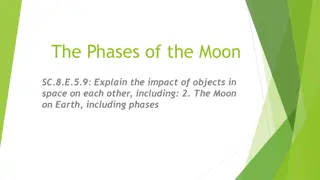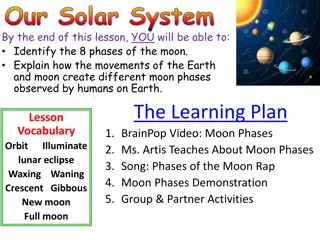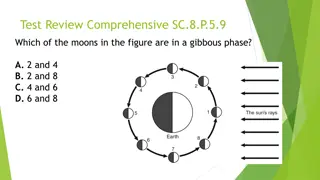Understanding the Phases of Gait Cycle
Gait is a rhythmic motion of the lower extremities characterized by alternating propulsive and retropulsive movements. The Gait Cycle consists of Swing Phase and Stance Phase, each crucial for walking efficiency. Stance Phase is further divided into stages like Initial Contact, Loading Response, Midstance, and Terminal Stance. Each stage plays a vital role in weight-bearing and propulsion during walking.
Download Presentation

Please find below an Image/Link to download the presentation.
The content on the website is provided AS IS for your information and personal use only. It may not be sold, licensed, or shared on other websites without obtaining consent from the author. Download presentation by click this link. If you encounter any issues during the download, it is possible that the publisher has removed the file from their server.
E N D
Presentation Transcript
GAIT Gait is rhythmic and characterised by alternating propulsive and retropulsive motion of the lower extremity. GAIT CYCLE It is a consequetive subsequent of one heel strike to another heel strike of the same extremity. eg. Right heel strike to another heel strike.
PHASES OF GAIT CYCLE It is divided into 2 phases- 1. Swing Phase 2. Stance Phase SWING PHASE It is defined as a phase of a gait cycle in which lower limb is in non-weight bearing and moving forward position. The swing phase occupies 40% of gait cycle. STANCE PHASE It is the phase during gait cycle when the foot is in contact with the ground in preparation of weight bearing and moving forward position. The stance phase occupies 60% of gait cycle.
STANCE PHASE 1.Initial Contact- It occurs at the instant at which the heel off the leaving the lower limb strikes the ground. This phase of stance prepares the moving limb for weight bearing as the opposite limb prepares to leave the ground because the portion of both feet are in contact with the ground during this phase. It represents the period of double support. During initial contact the trunk remains erect and neutral, pelvis is levelled, hip joint in opposition of 30 flexion or slight abduction and neutral rotation. Knee is close to full extension, tibia externally rotated. Ankle is neutral position, toes neither flexed nor extended.
2. Loading Response- It occurs immediately after initial contact and is point in the gait cycle in which the foot is in full contact with the ground. Forefoot loading usually occurs within first 20% of stance phase. During loading response trunk continues to be erect and neutral. Pelvis inclined forward approx 5 , hip maintains 30 of flexion, knee moves approx flexion of 15 -20 . Ankle plantarflexes to 15 from neutral. The toes are neither flexed nor extended.
3. Midstance- It is the point in the stance phase at which the body weight passes directly over the supporting limb. It is the period of single leg support in which the body is propelled forward over a fixed point. Trunk is erect, pelvis is levelled, the hip extend from the flexed, the knee moves from approx 20 flexion for the position of full extension. The ankle moves plantarflexion of loading response of approx 10 of dorsiflexion, this dorsiflexion is important for smooth progression of limb.
4.Terminal Stance- It is the point at which the heel of the weight bearing limb leaves the ground during this phase, weight bearing limbs begin to unload in preparation for the preswing and swing phase. This phase is characterised by a period of double support. The trunk is erect, pelvis posteriorly rotated to 5 , hip joint remains neutral, knee in a position of full extension. Ankle moves from the position of dorsiflexion to plantarflexion. The heel of the foot at this point is in contact with the floor in preparation for swing phase. The MTP joint are extended to 30 , IP joint are neutral.
5. Preswing- Although preswing is actually a period of double support. It is considered the part of the swing because this phase must occur in preparation of the limb to move in the swing phase. During preswing the trunk continues to be erect, pelvis 5 of posterior tilt, hip in neutral extension, knee flexion passively upto 30 to 35 in response to plantarflexion. MTP extends upto 60 , IP joint remains neutral.
SWING PHASE 1. Initial Swing- This begins the movement the toes of the weight bearing limb leaves the ground and continue until the midswing. During this phase acceleration of the swing limb created by the ankle plantarflexors. The hip flexor is important for toe clearance and forward advancement of the limb. The trunk remains erect, the pelvis begins to move forward, hip flexion upto 20
2.Midswing- It occurs as the limb film directly beneaththe body aligned with the opposite limb. Trunk continues to be erect, pelvis, neutral, hip 20 -30 flex, the knee moves toward extension, ankle and toes are neutral.
3.Terminal Swing- It is characterised by deacceleration. It occurs after midswing. When the foot and knee is extended in preparation for the initial contact . Trunk is erect, the pelvis 5 of forward rotation, hip continues to flexion of 20 , knee continues to extend approaching full extension. Ankle and toes are in neutral position.
PARAMETERS OF GAIT 1.Step Length- It is the length between ground and point of contact of the contralateral heel or toe with the ground. Eg. Step length on the left is measured as the distance from the point of contact with the right heel to the ground to the left heel with the ground. Step length are equal in normal gait.
2.Step duration- It is the amount of time spent during a single step. It is measured as a time between contact of the heel of one foot with the floor and the contact with the other heel to the floor. 3.Cadence- It is defined as no. of steps per minute. 4.Stride duration- The amount of time required to accomplish to complete stride.
5.Stride length- It is a sequence of motions that occur between two consequative repeations of the body parts and is commonly known as gait cycle. It is determined by measuring the distance from the point of heel contact of lower limb to the subsequent point of heel contact with the same lower limb.
COMMON PATHOLOGICAL GAIT 1.Antalgic Gait- Any disability resulting in pain in the lower limb in pelvic region may be result in antalgic pattern. Characteristics- It includes a decrease in duration of stance of the affected limb lack of weight shift over the stance limb the result of the degrees in stance phase on the affected side is a decrease in swing phase of the uninvolved limb. Limb creating a short step length in uninvolved limb a decrease in cadence and overall decrease in velocity.
2.Leg length Descripency (LLD) - In the side of the shorter length as the foot prepares to initial contact with the ground. The pelvis drops laterally in an attempts to lengthen the length in addition the individual may supinate the foot on the shorter side of the lengthen limb. The joint of the unaffected lower limb demonstrates exaggerated flexion in order to achieve swing through.
Weakness or paralysis of Gluteus medius- An individual gluteus medius weakness demonstrates a classic Trendelenburg gait posture in which the pelvis drop on an unaffected side during single limb support of the side of weakness. The dropping of the pelvis is due to inability of a gluteus medius to pull it's attachment on the femur, stabilise the pelvis in levelled. Another deviation sometimes found as gluteus medius larger involves the individual laterally flexing the trunk over the affected limb during single limb support. In order to maintain the COG over the BOS.
Weakness of Psoas Major- It's weakness is reflected in the patients in initiating swing phase in order to compensate for the psoas weakness. The individual rotate the limb externally at the hip and uses the hip adductors to achieve swing through. Inability to Quadriceps- Compensation occurs by the patient manually pushing the knee into extension in initial contact also known as hand to knee gait.
Steppage Gait- Also known as High stepping gait. It is because of weakness of dorsiflexors in this excessive hip and knee flexion compensates for the drop foot and allows the swing through of the affected foot without dragging the toes on the floor initial contact occurs at the forefoot rather than the heel. Weakness or paralysis of Ankle plantarflexors- A calcaneal gait pattern is typical in individual who have weakness or paralysis of ankle plantarflexors. The abnormality is seen during the phase of single limb support. Their is no propulsion because of the weakness of plantarflexors.
Weakness or paralysis of Gluteus Maximus- It results in the inability to counter the flexion movement at the hip at the point of individual contact. The individual must compensate by quickly moving the trunk posteriorly into initial contact so that the weight of the trunk can oppose the flexion movement and this allows to maintain an upright posture during gait cycle. It is also known as Jack Knifing gait.




